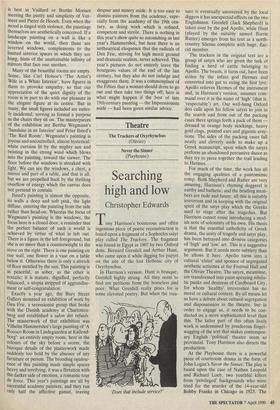ARTS
Exhibitions 1
Empty rooms
Andrew Solomon
Drama, anguish and rapture are the hallmarks of Mediterranean painting, whereas clarity of light and accuracy of depiction and Protestant modesty of scale have always been northern values; but the triumph of northern art is its ability to move us not despite but rather by dint of such restraint and exactness. Scandinavian Interiors, which runs through Easter at the Bury Street Gallery (11 Bury Street, SW1), presses us to consider the relation between emotion and the visual by presenting a series of introspective and emotionally charged paintings of empty or nearly emp-
ty rooms. Two of the pictures are Swedish, all the others Danish; they date from between 1860 and 1920. Though some of them make us wonder merely what gives a room its character, the best make us examine the basis on which we locate complex sentiments in the representation of something that is essentially neutral, make us ask why a particular effect of light and shadow can invest the landscape of two curtained windows and a chest of drawers with wildest joy, why elsewhere a shadow across a tall lintel can make us meditative and slightly sad.
The paintings in the exhibition are beautiful. They have the warmth and innocent energy of the Impressionists in conjunction with the precision of the great artists of the Northern Renaissance, what Perfectly balanced: Peter Ilsted's 'The Red Room', oil on canvas, 1915 is best in Vuillard or Berthe Morisot meeting the purity and simplicity of Ver- meer and Pieter de Hooch. Even when the mood is tinged with violence, the paintings themselves are aesthetically conceived. If a landscape painting on a wall is like a window on the world, then these are inverted windows, complements to the limited interior spaces in which they are hung, hints of the unattainable infinity of mirrors that face one another.
Many of the beautiful rooms are empty. Some, like Carl Holsoe's 'The Artist's Wife in a White Interior', have figures in them to provoke empathy, so that our appreciation of the quiet dignity of the room is in part to do with our pleasure in the elegant figure at its centre. But in many, the small figures included are entire- ly incidental, serving as formal a purpose as the chairs they sit on. The masterpieces of the exhibition are Bertha Wegmann's `Sunshine in an Interior' and Peter Ilsted's `The Red Room'. Wegmann's painting is joyous and uncontrolled, almost hysterical: white curtains lit by the mighty sun and twisting in the strong wind which blows into the painting, toward the viewer. The floor before the windows is streaked with light. We can see the windows, a chest, a mirror and part of a table, and that is all, but we are propelled back by the thrilling overflow of energy which the canvas does not pretend to contain.
Ilsted's painting is almost the opposite, its walls a deep and soft pink, the light diffuse, entering the painting from the side rather than head-on. Whereas the focus of Wegmann's painting is the windows, the focus here is a closed door, a reminder that the perfect balance of such a world is achieved by virtue of what is left out. There is a figure in the left foreground, but she is no more than a counterweight to the stove on the right. There is one painting on one wall, one flower in a vase on a table below it. Otherwise there is only a stretch of floor mottled by the sun. This painting is as peaceful, as sober, as the other is ecstatic; it is mature, dignified, perfectly balanced, a utopia stripped of aggrandise- ment or self-congratulation.
Exactly a year ago, the Bury Street Gallery mounted an exhibition of work by Den Frie, a secessionist group that broke with the Danish academy at Charlotten- berg and established a salon des refuses. The masterwork of that exhibition was Vilhelm Hammershoi's large painting of 'A Rococo Room in Lindegaarden at Kallend- borg': an entirely empty room, here in the colours of the sky before a storm, the baroque details of the plasterwork made suddenly too bold by the absence of any furniture or person. The brooding opalesc- ence of this painting made simple spaces heavy and terrifying; it was a flirtation with the darker side of emotion, a romantic tour de force. This year's paintings are all by successful academy painters, and they run only half the affective gamut, leaving despair and misery aside. It is too easy to dismiss painters from the academy, espe- cially from the academy of the 19th cen- tury, as doing work which is refined, competent and sterile. There is nothing in this year's show quite so astonishing as last year's Hammershoi, but here there is an untheatrical eloquence that the radicals of Den Frie, striving for high moral ground and dramatic realism, never achieved. This year's pictures do not entirely leave the bourgeois values of the end of the last century, but they also do not indulge and exaggerate them. It was a commonplace of the Fifties that a woman should dress to go out and then take two things off; here is what might happen if the best of late 19th-century painting — the Impressionists aside — had been given similar advice.



























































 Previous page
Previous page